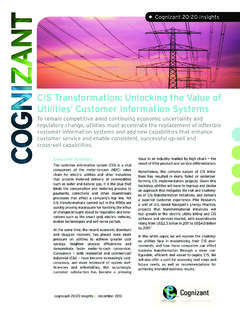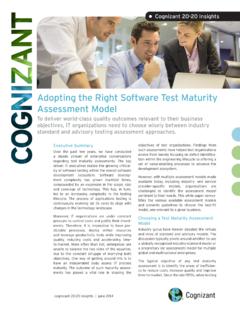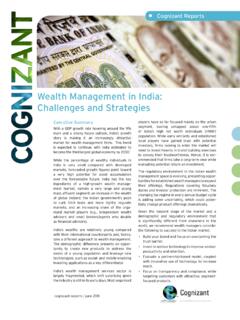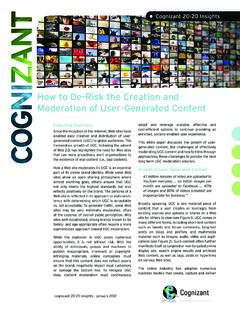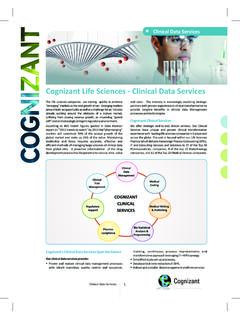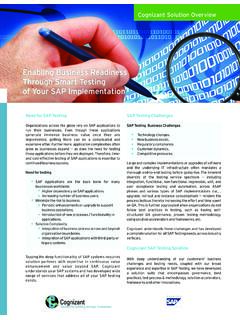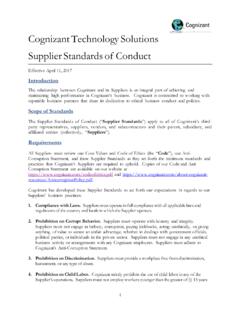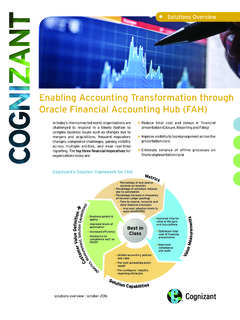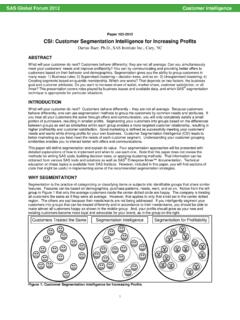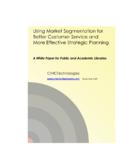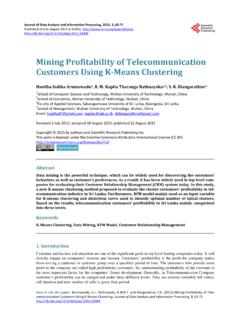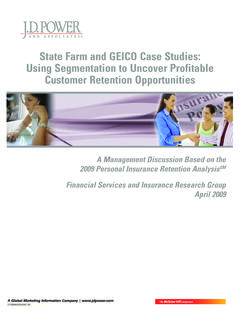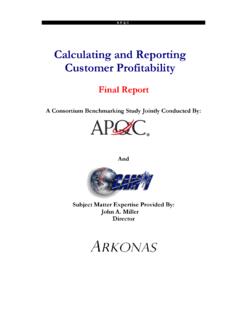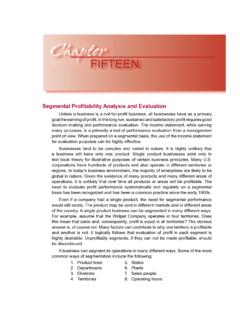Transcription of Divide and Prosper: Targeting Key Customer Segments to ...
1 Divide and prosper : Targeting Key Customer Segments to Drive Bank ProfitsIn today s slow-growth era, a seven-step framework can help banks identify and sell to their highest value Customer SummaryNorth American retail banks face multiple challenges, including a low interest rate envi-ronment, rising regulatory costs and customers spurning traditional branches. In response, they are moving to reinvent their operating models, better understand their customers and grow their share of wallet within their most profitable than accept vague classifications such as mass affluent, leading banks are organizing around the specific needs of their most profitable Customer Segments .
2 This white paper describes why it is essential to organize around Customer Segments rather than geographies or product silos to grow share of wallet, boost Customer retention and improve lead generation, while increasing branch and call center productivity. We end with our proven seven-step framework for banks to identify and sell to their most profitable client as Usual = High-Risk StrategyNorth American retail banks are facing a prolonged period of low interest rates and higher compliance costs, both of which make it harder to earn a reasonable rate of return on invested capital.
3 These financial institutions also need to rethink their retail strategies as younger customers shun branches in favor of online banking or even abandon conventional banks for nontraditional players, such as PayPal, Google Wallet and Amazon Payments. Amid these changes, banks are shifting from a focus on Customer acquisition to capturing a greater share of wallet from their most profitable customers. There is room for growth here; a March 2012 report from BAI Research found that financial institutions typically capture only 46% of a Customer s total deposit The percentage of total balance captured is even lower for other types of accounts, at just 10% for total loan balances and 2% for total investment balances.
4 The rest represents an untapped market that is available for primary financial insti-tutions that can understand Customer needs and can convince existing customers to consolidate more of their banking and investment activities with them. Moving from strategic intent to operation-ally capturing a greater share of wallet requires thoughtful tactics that enable cross- and up-selling. Identifying and seizing these oppor-tunities requires a deeper understanding of Customer needs, wants and expectations. It is no surprise that many retail banks are embarking on efforts to segment clients and customize service Cognizant 20-20 Insightscognizant 20-20 insights | november 20132levels using analytics and data-driven decisions.
5 Another BAI Research study2 shows segmenta-tion is the top investment area for marketing and product development at banks with more than $ billion in assets. For banks with under $ billion in assets, investments in relationship packaging and pricing strategies are followed closely by segmentation (which helps drive the effectiveness of their strategies). Segmentation per se is nothing new. But historical and broad definitions such as mass affluent and affluent vary across banks and are not precise enough to generate higher revenue and profits in today s challenging market.
6 To succeed, banks must understand the underlying emotive needs and desires of specific client Segments and use those insights to restructure around their most profitable Customer some banks, the segmen-tation exercise may uncover the classic 80% of profits from 20% of customers truism that is commonly found among our clients and further affirmed by industry research. Some banks may choose to focus not on customers who are the most profitable today but on those they expect will grow more profitable as the relationship matures.
7 But whichever Segments they identify as most valuable, banks that fully understand and serve specific Segments are most likely to prosper amid continuing competitive pressure and technological change. Some of the most important evidence supporting the effectiveness of this strategy comes from customers themselves. A survey conducted by BAI Research found that consumers are eager for their banks to approach them with cross-sell opportunities that help them better manage their financial Developing and Targeting such offers, however, requires a more in-depth under-standing of the high-value Customer Segments than what most banks have today.
8 Many banks lack the internal systems, processes, data and insights to identify and proactively serve their highest-value High-Value Segments In partnership with BAI and in our work with clients, we have identified five distinct Customer Segments that can help banks tailor their product and service offerings (see Figure 1). Each segment offers different revenue potential, investment objectives, comfort with technology, levels of satisfaction with their current financial institu-tion and service preferences. Banks can combine an in-depth understanding of each segment with their business objectives to refine cross-sell efforts that maximize their share of wallet and long-term profitability.
9 Deeper understanding of each segment will also help banks adjust their IT and staff investments to maximize profit potential. Marginalized Middles: This is the largest banking segment and consists of individuals who are younger than the average Customer and have the second highest revenue per household. Compared with other Segments , these individuals are the least satisfied with their primary financial institution, most confused about bank fees and most likely to pay someone else to handle their finances. The size of this group, and its tendency to visit branches less than other Segments , may make it imprac-tical to provide these customers with personal-ized service.
10 For Marginalized Middles, consider a greater focus on self-service channels and easy-to-understand marketing messages as cost-effective ways to increase Customer satis-faction and solidify the relationship. Satisfied Traditionalists: This segment accounts for almost 20% of customers and represents the oldest customers with the sec-ond-highest total deposit revenue potential per household and the highest investment balance. The profitability of this group is limited by its low receptivity to product offerings and to online, mobile and debit services.
